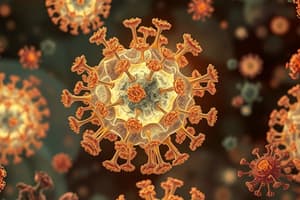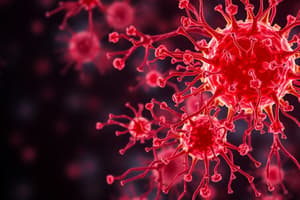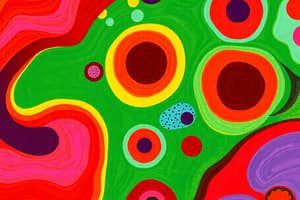Podcast
Questions and Answers
Which type of immunity acts as the first line of defense against infectious organisms?
Which type of immunity acts as the first line of defense against infectious organisms?
- Adaptive immunity
- Innate immunity (correct)
- Acquired immunity
- Cell-mediated immunity
Which cells are primarily involved in the process of phagocytosis?
Which cells are primarily involved in the process of phagocytosis?
- Mast cells and plasma cells
- Neutrophils, monocytes, and tissue macrophages (correct)
- B lymphocytes and T lymphocytes
- Natural killer cells and dendritic cells
What type of receptors do innate immune cells use to recognize pathogens?
What type of receptors do innate immune cells use to recognize pathogens?
- Immunoglobulin receptors
- Major histocompatibility complex receptors
- Antigen receptors
- Membrane receptors including those for mannose residues (correct)
Innate immunity can be characterized by which of the following features?
Innate immunity can be characterized by which of the following features?
Which of the following best describes adaptive immunity?
Which of the following best describes adaptive immunity?
What type of immune response is NOT primarily mediated by Toll-Like Receptors (TLRs)?
What type of immune response is NOT primarily mediated by Toll-Like Receptors (TLRs)?
What role do phagocytic cells play during an inflammatory response?
What role do phagocytic cells play during an inflammatory response?
Which TLR is primarily activated by double-stranded RNA?
Which TLR is primarily activated by double-stranded RNA?
Which statement about the recognition molecules of innate immunity is true?
Which statement about the recognition molecules of innate immunity is true?
Which of the following cells are classified as innate lymphoid cells (ILCs)?
Which of the following cells are classified as innate lymphoid cells (ILCs)?
Which statement about TLRs is correct?
Which statement about TLRs is correct?
What is the primary role of TLR4?
What is the primary role of TLR4?
Which TLR is associated with recognizing profilin from Toxoplasma spp.?
Which TLR is associated with recognizing profilin from Toxoplasma spp.?
Which of the following TLRs is involved in IFN-α and IFN-β production?
Which of the following TLRs is involved in IFN-α and IFN-β production?
What distinguishes TLR10 from other TLRs?
What distinguishes TLR10 from other TLRs?
What do TLRs primarily function in?
What do TLRs primarily function in?
Which TLRs are involved in detecting viral products?
Which TLRs are involved in detecting viral products?
What does the acronym PAMP stand for in the context of TLRs?
What does the acronym PAMP stand for in the context of TLRs?
Which of the following is recognized by TLRs on bacterial cell surfaces?
Which of the following is recognized by TLRs on bacterial cell surfaces?
What is the role of non-TLR adapter molecules in TLR function?
What is the role of non-TLR adapter molecules in TLR function?
What type of pathogen does TLR4 specifically recognize?
What type of pathogen does TLR4 specifically recognize?
Which type of nucleic acid is primarily recognized by TLR3?
Which type of nucleic acid is primarily recognized by TLR3?
Which TLR is NOT primarily associated with microbial detection?
Which TLR is NOT primarily associated with microbial detection?
What motif characterizes the extracellular domain of TLRs?
What motif characterizes the extracellular domain of TLRs?
Which domain is conserved among TLRs and IL-1 receptors?
Which domain is conserved among TLRs and IL-1 receptors?
What role does LPS-binding protein (LBP) play in the recognition of LPS?
What role does LPS-binding protein (LBP) play in the recognition of LPS?
Which accessory protein complexes with the LPS-CD14-TLR4 molecule?
Which accessory protein complexes with the LPS-CD14-TLR4 molecule?
What initiates LPS-induced cell signaling?
What initiates LPS-induced cell signaling?
What type of protein is CD14?
What type of protein is CD14?
What is the purpose of the cysteine-rich motif flanking the leucine-rich repeat motif in TLRs?
What is the purpose of the cysteine-rich motif flanking the leucine-rich repeat motif in TLRs?
What is produced as a result of the dissociation of LBP upon LPS binding?
What is produced as a result of the dissociation of LBP upon LPS binding?
Which type of immunity is primarily mediated by T lymphocytes?
Which type of immunity is primarily mediated by T lymphocytes?
What is a key characteristic that distinguishes ILCs from T and B lymphocytes?
What is a key characteristic that distinguishes ILCs from T and B lymphocytes?
Which immune cell type is responsible for defending against extracellular pathogens?
Which immune cell type is responsible for defending against extracellular pathogens?
What function does the MHC system serve in the adaptive immune response?
What function does the MHC system serve in the adaptive immune response?
ILCs are similar to T and B lymphocytes but differ in which aspect?
ILCs are similar to T and B lymphocytes but differ in which aspect?
Which of the following is NOT a major cell population involved in the immune response?
Which of the following is NOT a major cell population involved in the immune response?
What type of immunity is mediated by B lymphocytes?
What type of immunity is mediated by B lymphocytes?
In the context of the immune response, what does not apply to ILCs?
In the context of the immune response, what does not apply to ILCs?
Which group of ILCs is primarily involved in activating macrophages to kill microbes?
Which group of ILCs is primarily involved in activating macrophages to kill microbes?
What is the role of IL-4, IL-5, IL-9, and IL-13 from Group 2 ILCs?
What is the role of IL-4, IL-5, IL-9, and IL-13 from Group 2 ILCs?
Which ILC group contributes to increased resistance to extracellular bacteria?
Which ILC group contributes to increased resistance to extracellular bacteria?
Which cells are activated by Group 3 ILCs to produce antimicrobial peptides?
Which cells are activated by Group 3 ILCs to produce antimicrobial peptides?
What is the main function of increased intestinal peristalsis in relation to helminths?
What is the main function of increased intestinal peristalsis in relation to helminths?
What type of pathogens do Group 1 ILCs primarily increase resistance against?
What type of pathogens do Group 1 ILCs primarily increase resistance against?
Which effector molecule is most associated with the destruction of mucosal epithelial cells?
Which effector molecule is most associated with the destruction of mucosal epithelial cells?
What role do antimicrobial peptides play in the immune response?
What role do antimicrobial peptides play in the immune response?
Which cytokine is NOT associated with Group 2 ILCs?
Which cytokine is NOT associated with Group 2 ILCs?
What is the result of increasing mucus secretion in the presence of helminths?
What is the result of increasing mucus secretion in the presence of helminths?
Flashcards
Innate Immunity
Innate Immunity
The body's first line of defense against infection, using physical barriers, proteins (like complement), and immune cells like ILCs and phagocytes.
Adaptive Immunity
Adaptive Immunity
Antigen-specific immune response involving T and B cells, activated by innate immunity, to eliminate pathogens.
Phagocytic cells
Phagocytic cells
Immune cells that ingest and destroy pathogens and toxins.
Inflammation
Inflammation
Signup and view all the flashcards
Complement System
Complement System
Signup and view all the flashcards
Pathogen-Associated Molecular Patterns (PAMPs)
Pathogen-Associated Molecular Patterns (PAMPs)
Signup and view all the flashcards
NK cells
NK cells
Signup and view all the flashcards
Neutrophils, monocytes, macrophages
Neutrophils, monocytes, macrophages
Signup and view all the flashcards
Toll-like Receptors (TLRs)
Toll-like Receptors (TLRs)
Signup and view all the flashcards
TLR3 activation
TLR3 activation
Signup and view all the flashcards
TLR4 activation
TLR4 activation
Signup and view all the flashcards
TLR7/TLR8 activation
TLR7/TLR8 activation
Signup and view all the flashcards
TLR9 activation
TLR9 activation
Signup and view all the flashcards
Innate immune response pathway
Innate immune response pathway
Signup and view all the flashcards
TLR5 activation
TLR5 activation
Signup and view all the flashcards
TLR recognition
TLR recognition
Signup and view all the flashcards
TLRs
TLRs
Signup and view all the flashcards
PRRs
PRRs
Signup and view all the flashcards
PAMPs
PAMPs
Signup and view all the flashcards
LPS
LPS
Signup and view all the flashcards
TLR function
TLR function
Signup and view all the flashcards
TLR location
TLR location
Signup and view all the flashcards
TLR specificity
TLR specificity
Signup and view all the flashcards
TLR types
TLR types
Signup and view all the flashcards
TLR Structure
TLR Structure
Signup and view all the flashcards
MD2 Role
MD2 Role
Signup and view all the flashcards
TIR Domain Function
TIR Domain Function
Signup and view all the flashcards
TLR Signaling
TLR Signaling
Signup and view all the flashcards
Cytokine Production
Cytokine Production
Signup and view all the flashcards
Immune Response Activation
Immune Response Activation
Signup and view all the flashcards
Adaptive Immune System
Adaptive Immune System
Signup and view all the flashcards
MHC System
MHC System
Signup and view all the flashcards
Cell-mediated Immunity
Cell-mediated Immunity
Signup and view all the flashcards
Humoral Immunity
Humoral Immunity
Signup and view all the flashcards
ILCs (Innate Lymphoid Cells)
ILCs (Innate Lymphoid Cells)
Signup and view all the flashcards
RAGs (Recombination Activating Genes)
RAGs (Recombination Activating Genes)
Signup and view all the flashcards
How are ILCs different from Adaptive Lymphocytes?
How are ILCs different from Adaptive Lymphocytes?
Signup and view all the flashcards
What's the role of the MHC system for Adaptive Immunity?
What's the role of the MHC system for Adaptive Immunity?
Signup and view all the flashcards
What are some functions of ILC1?
What are some functions of ILC1?
Signup and view all the flashcards
What are some functions of ILC2?
What are some functions of ILC2?
Signup and view all the flashcards
What are some functions of ILC3?
What are some functions of ILC3?
Signup and view all the flashcards
How do ILCs help in mucosal defense against helminths?
How do ILCs help in mucosal defense against helminths?
Signup and view all the flashcards
How do ILCs help in mucosal defense against bacteria?
How do ILCs help in mucosal defense against bacteria?
Signup and view all the flashcards
What is the role of ILC3 in mucosal defense?
What is the role of ILC3 in mucosal defense?
Signup and view all the flashcards
What are the main groups of ILCs?
What are the main groups of ILCs?
Signup and view all the flashcards
Study Notes
General Features of the Immune System
- The immune system protects against infectious organisms (bacteria, viruses, fungi, parasites) and cancer
- Immune responses can cause pathologies, whether normal responses to foreign antigens or from immune system aberrations.
- A functional immune system is vital for protection against disease.
Innate Immunity (Nonspecific Immunity)
- Innate immunity is the first line of defense
- It is non-specific to the antigen, meaning it doesn't target a specific pathogen; lacks memory
- It includes anatomic barriers (skin, mucous membranes), physiologic barriers (pH, temperature), phagocytic cells (neutrophils, monocytes, tissue macrophages), innate lymphoid cells (ILCs), and plasma proteins (complement).
- Phagocytic cells ingest and destroy pathogens and neutralize toxins
- Inflammation involves vascular, permeability, and cellular phases.
- Pathogen-associated molecular patterns (PAMPs) are recognized by pattern recognition receptors (PRRs).
- Damage-associated molecular patterns (DAMPs) also trigger innate immune responses.
Recognition Molecules of Innate Immunity (Pathogen-Associated Molecular Patterns)
- Recognition molecules in innate immunity allow non-lymphocytes to identify pathogens.
- These molecules sense microbial structures (PAMPs) and endogenous inflammatory molecules (DAMPs).
- Various forms of PRRs include collectins, pentraxins, TLRs, RLRs, and NLRs.
- TLRs recognize bacterial products (LPS, peptidoglycan), viral (double-stranded RNA), or fungal (a-glucans) components.
Toll-Like Receptors
- TLRs are membrane molecules activated by various microbial pathogens' PAMPs.
- These molecules initiate inflammatory responses and link innate to adaptive immune systems.
- They vary in cellular expression and signaling pathways.
Adaptive Immunity (Specific Immunity)
- Adaptive immunity is a second line of defense, with antigen specificity, diversity, memory.
- It includes cell-mediated immunity (T lymphocytes against intracellular pathogens), and humoral immunity (B lymphocytes against extracellular pathogens).
- T lymphocytes recognize antigens bound to proteins called major histocompatibility (MHC) molecules.
- Two major types of MHC molecules exist (class I and II)
- B cells and T cells are main cells of adaptive immunity.
Cells and Tissues of the Immune System: Lymphoid Tissues
- Lymphoid tissues are crucial for immune development and adaptive immunity.
- They are classified into primary and secondary lymphoid organs.
- Primary: thymus, bursa of Fabricius, bone marrow, ileal Peyer's patches, fetal liver. Responsible for antigen-independent T and B cell development.
- Secondary: spleen, tonsils, Peyer's patches, lymph nodes. Involved in antigen-dependent immune responses and generating adaptive immunity.
- Tertiary lymphoid tissues are functionally equivalent to secondary, and are often located near epithelial surfaces. Examples are mucosal-associated lymphoid tissue (MALTs), gut-associated lymphoid tissues (GALTs).
Antigens
- Antigens are recognized and responded to, initiating the immune response.
- Include foreign viruses, bacteria, parasites, and fungal proteins.
- Antigens are transported to lymphoid organs via lymph or dendritic cells.
Innate Lymphoid Cells (ILCs)
- ILCs are a heterogeneous population of cells that are not antigen-specific.
- They are involved in defenses against infectious microbes, lymphoid-tissue formation, and tissue remodeling.
- They are categorized by cytokine profiles (ILC1, ILC2, and ILC3).
T Lymphocytes
- T lymphocytes are small, non-granular cells, comprising ~50-70% of peripheral blood mononuclear cells.
- They develop in bone marrow, mature in thymus, and are located in secondary lymphoid tissues (e.g. lymph nodes, spleen).
- ILCs, macrophages, and dendritic cells also present antigens to cells.
- T cells are classified into CD4+ (helper T lymphocytes) and CD8+ (cytotoxic T lymphocytes).
B Lymphocytes
- B lymphocytes constitute ~5-20% of peripheral blood mononuclear cells.
- B lymphocyte development occurs in two phases:
- Antigen-independent in primary lymphoid tissues (bone marrow, ileal Peyer's patches).
- Antigen-dependent in secondary lymphoid tissues (spleen, lymph nodes). -B lymphocytes express immunoglobulins (IgM and IgD) on their surface.
Mononuclear Phagocytic System (Monocyte-Macrophage System)
- Primarily composed of monocytes (circulating) and macrophages (tissue-based).
- Function in immunity, inflammation, and tissue remodeling/repair.
- Includes cells like macrophages (e.g. Kupffer cells, microglia, alveolar macrophages, mesangial cells).
Dendritic Cells
- A specialized population of antigen-presenting cells that differentiate from the myeloid lineage.
- Highly efficient in presenting antigens to T lymphocytes, initiating primary immune responses to protein antigens.
Natural Killer (NK) Cells
- Large granular lymphocytes that comprise ~5-15% of peripheral blood mononuclear cells.
- Primarily involved in early responses to cancerous and virally infected cells.
- Do not have antigen-specific receptors; instead, they exert cytotoxic effects based on activating and inhibitory receptors.
Cytokines: Messenger Molecules of the Immune System
- Cytokines are small soluble proteins produced by immune and non-immune cells.
- They regulate the immune response, acting locally (paracrine) or systemically (endocrine)
- Many have pleiotropic (many targets), redundant, synergistic, or antagonistic effects.
Structure and Function of Histocompatibility Antigens
- MHC molecules are key for recognizing self vs. non-self.
- They function in antigen presentation to T lymphocytes.
- MHC molecules are responsible for the compatibility of transplanted tissues.
Disorders of the Immune System: Hypersensitivity Reactions
- Involves inappropriate or misdirected responses to antigens in sensitized hosts.
- Classified into types I (anaphylaxis, allergies), II (cytotoxic), III (immune complexes), and IV (delayed-type).
Disorders of the Immune System: Autoimmune Diseases
- Characterized by an immune response to self-antigens.
- Can be organ-specific or systemic.
Disorders of the Immune System: Immunodeficiency Syndromes
- Primary: genetic defects, affecting both humoral and cellular immunity
- Secondary: acquired defects resulting from infections, malnutrition, or immunosuppression.
Immune Checkpoints
- Immune checkpoint proteins regulate lymphocyte activation.
- Tumor cells can exploit checkpoints to evade immune detection (immune evasion).
Amyloidosis
- Protein misfolding leads to amyloid fibril formation: deposition as extracellular β-pleated sheets.
- Can be genetic (e.g., transthyretin) or secondary (e.g., SAA).
Studying That Suits You
Use AI to generate personalized quizzes and flashcards to suit your learning preferences.



